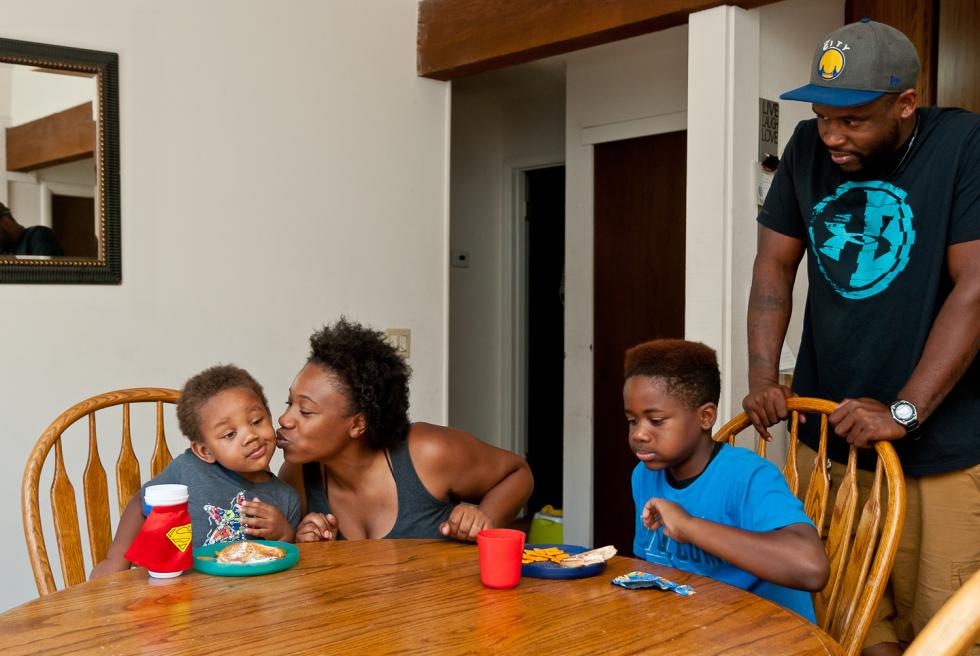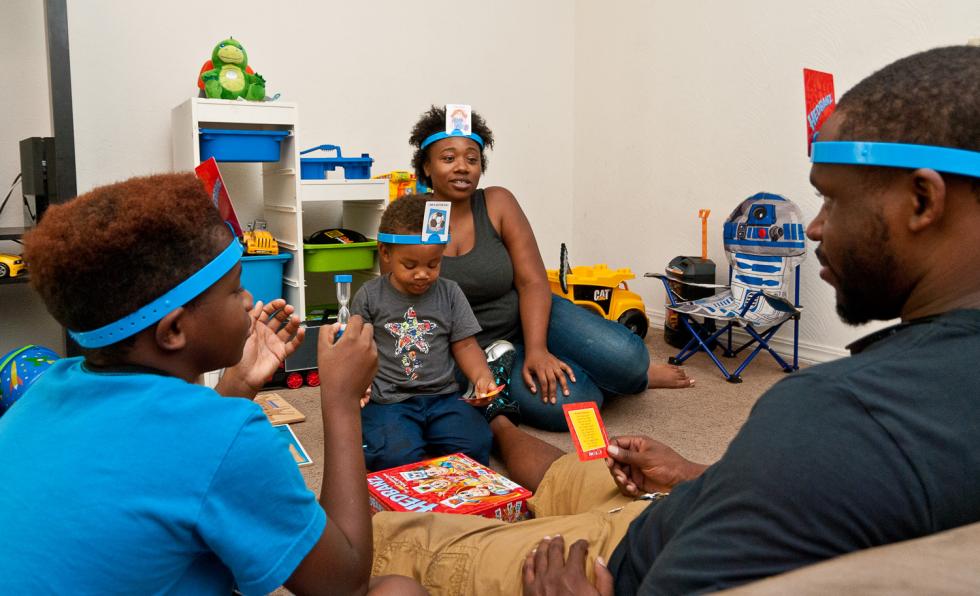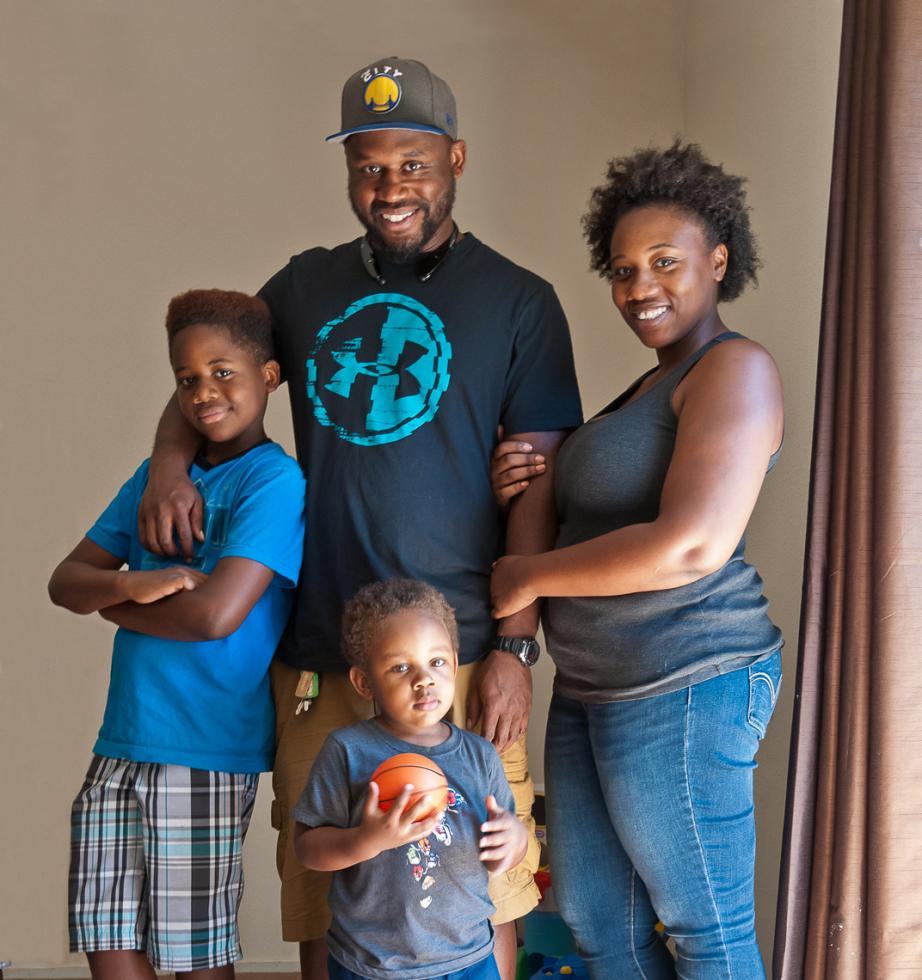At 17 years old, Steven Hayes didn’t know what he wanted to do with his life. Until one day, he got a phone call from a U.S. Marines recruiter that his buddy had talked to. Hayes says the recruiter provoked him by asking if he was not as tough as his friend. Hayes defiantly said no. “Six months later, I was in boot camp.” A few years later, at 21 years old, he deployed to Iraq.
During Hayes’ tour — for 11 months and 23 days — his wife, Dejauna, tried to go about her normal activities, kept their house in Florida running, paid the bills and raised their toddler son, Kavon. Then, like all who serve in combat, Hayes returned from deployment a changed man. “It was a transitional time,” says Hayes, now 29 years old. “My wife will tell you, I was there, but I wasn’t really there.”
Hayes immediately enrolled in school in Florida. But he couldn’t focus on his studies and eventually dropped out. He also struggled to bring in a steady income. Soon, he and his family had no choice but to move in with his mother in her two-bedroom apartment in his hometown of Sacramento. Hayes and Dejauna slept on the floor alongside Kavon, and their younger son, Travis, slept in the bed with his grandma.
The trials Hayes underwent upon returning from deployment resemble those experienced by so many veterans, who are at risk for unemployment, homelessness, substance abuse, post-traumatic stress disorder and suicide. Some 22 million veterans are now living in the U.S., representing a lot of people who might need help. Nonprofit organizations such as Volunteers of America and The Soldiers Project have stepped in to offer a hand to veterans in need — and their families.
From left: Travis, Dejauna, Kavon and Steven Hayes in their
Sacramento home.

Deployment, especially to a war zone, can lead to all sorts of problems for the families of active-military members or veterans, says Becca Bettis, director of veterans services for Volunteers of America of Northern California and Northern Nevada. When a soldier deploys, a spouse may be left at home to constantly fret about their partner’s safety. That’s stressful. Or a spouse might feel hurt and alienated when a veteran develops symptoms of PTSD. A child (there are over 1.2 million school-aged children of U.S. servicemen and women) may turn anxious with one parent absent. “When a soldier goes to war,” Bettis says, “they all go to war.”
In the U.S., about 11 percent of our homeless adult population are veterans, according to the National Coalition for Homeless Veterans. Of this group, 70 percent have substance abuse problems, 51 percent have disabilities and 50 percent have serious mental illness. Homelessness among veterans, though, has sharply declined since 2009 when a national effort launched to curb this problem. California has the nation’s largest veteran population at 1.7 million, or roughly 4 percent of the state’s total population and 8 percent of the national veteran population, making homelessness — and its related issues — an ongoing challenge to address.
Related: Veterans Could Use a Hand-Up
In Sacramento County, 313 homeless veterans were counted during a point-in-time count last year. But this count doesn’t tell the entire story, according to Ryan Loofbourrow, CEO of Sacramento Steps Forward. Since that count, his organization has housed 729 veterans. “Through daily outreach and intake we know there are 232 individuals on our active queue and we still identify 50 new veterans experiencing homelessness per month,” Loofbourrow says, adding that better access to housing is key to bringing homelessness down.
Two distinct populations of homeless veterans exist, according to Bettis: Those who served in Vietnam tend to be chronically homeless and have severe physical disabilities and mental health needs; the newly homeless, who enlisted around age 18 or who left jobs to serve in the conflicts in Iraq and Afghanistan, return lacking civilian job skills. In fact, young veterans, ages 18 to 30, are twice as likely as their counterparts in the general population to be homeless.
“When a soldier goes to war, they all go to war.”Becca Bettis, director of veteran services, Volunteers of America of Northern California and Northern Nevada
A veteran’s inability to find and keep employment is a main cause of homelessness, according to Bettis. A stable income and stable housing go hand-in-hand. That’s where the VOA of Northern California and Northern Nevada comes into play.
Launched locally in 1911, VOA bases its veterans services program on the campus of the Sacramento VA Medical Center, at the former Mather Air Force Base. The program provides transitional housing and employment programs for vets in Sacramento, Yolo, El Dorado and Placer counties. The organization has administered the U.S. Department of Veterans Affairs’ Supportive Services for Veteran Families program, which assists “extremely low-income” or “very low-income individuals” (to qualify, the household income must not exceed 30 percent of the area’s median income).
In the 2014-15 grant year, the local VOA served 2,324 homeless and low-income veterans; of those, 1,097 obtained or retained permanent housing, and 182 participated in the organization’s Permanent Supportive Housing program, which provides longer-term assistance for veterans with disabilities. And some 332 participants received employment and job services, which include workshops on resume writing, interview preparation and job referrals, and training in maintenance, landscaping, janitorial, truck driving and other vocations.
About two years ago, Hayes got involved with the VOA’s veterans services — which opened a new community center at Mather in March 2015, adjacent to its Veterans Family Services administrative building — and took advantage of the SSVF program, which paid the deposit and first month’s rent on a house for Hayes and his family. He was also part of the PSH program, paying a discounted rent based on his income, at $400. “It’s been a really good opportunity for us,” says Hayes, who has earned his associate’s degree from University of Phoenix and now works at Sportsman’s Warehouse in Rocklin.
Healing Hidden Wounds
Housing and employment represent two basic needs. But veterans might have other needs that go deeper and remain invisible, such as treatment for post-traumatic stress disorder. “The stuff you did out there is going to have a lasting impact,” says Hayes, who hesitates when asked if he might have PTSD, explaining that some of his buddies had far worse experiences than he did.
While about 4 percent of the general population will deal with PTSD in a given year, veterans suffer from this disorder at much higher rates. Of those who served in operations Iraqi Freedom and Enduring Freedom, 11 to 20 percent will have PTSD. Twelve percent of Gulf War vets and 15 percent of vets from Vietnam (although 30 percent have had PTSD at some point in their postwar lives) also suffer from PTSD, according to the U.S. Department of Veterans Affairs.
Female veterans, of which there are now about 2 million in the U.S. and who constitute the fastest-growing group of veterans, may experience different types of traumas that lead to PTSD, such as military sexual trauma. In general, women are more than twice as likely to develop PTSD because they are more prone to experience sexual assault, which is more likely than other life events to cause the disorder, according to the department. Among women who served in the conflicts in Iraq and Afghanistan, 20 percent have been diagnosed.
The symptoms of PTSD — there are many and include flashbacks, guilt, loss of interest in enjoyable activities, difficulty sleeping, being on edge and memory problems — can impact an entire family, as the partner and children struggle to understand changed behaviors, attitudes and triggers. PTSD also increases the risk that a person will develop a drinking or drug problem, which could lead to domestic violence, child abuse or marital discord.
Another invisible wound of war: “moral injury,” which occurs when a soldier commits an act that violates his moral conscience and feels a deep sense of shame. “What I said to my son when he got on the bus is make sure to keep your moral compass,” says Bettis, whose son is a Marine. “But when you go to a place like [Afghanistan] everything goes out the window.”
Moral injuries prompt some veterans to contact The Soldiers Project, a national nonprofit organization that provides no-cost, confidential and unlimited counseling to post-9/11 veterans, active military and their loved ones. Clients may also suffer from grief, traumatic brain injury or, primarily among women, sexual trauma. Shing Long oversees the Sacramento chapter’s 36 licensed therapists — all are volunteers. In 2015, the chapter provided 483 hours of therapy for 101 clients. The local chapter serves much of Northern California, and clients can access free counseling indefinitely; there’s no cap on the service.
Long’s husband served in the Navy for 12 years, and she took it upon herself to regularly gather other military wives together for weekly luncheons to converse and connect while their husbands were away. She knew about the impact of military service on the whole family from her own experience and from conversations with these other women, which often revolved around the stresses of deployment, so she got involved with The Soldiers Project in 2015.
During a deployment, the spouse left behind becomes the sole caregiver for the children, must handle all household chores — while possibly holding down a job — and has lost a companion. Children are more likely to exhibit behavioral problems while a parent is deployed. Upon returning, the veteran may struggle to assimilate back into the family unit. Children have gotten older, people change and the returning parent may not know his or her place anymore. And veterans may not feel comfortable seeking help. “That’s just the military — taking care of everyone else before yourself,” Long says.
The Soldiers Project can counsel the individual or couple on how to reintegrate the service member. Long wants people to understand that not all military families experience struggles, and for those that do, help exists. “Just because you’re in a military family doesn’t set you up for doom and gloom,” Long says.
Home Sweet Home
On a hot July afternoon, Hayes and his family settle onto the living room floor of their house in Sacramento for a game of HedBanz, which requires the guesser to wear an unknown clue on his forehead and ask questions, while the other players offer hints and a timer counts down. Kavon, now 10 years old and about to start fifth grade, has his dad’s humor, punctuating the game with witty remarks, while his 3-year-old brother, Travis, squeals and barrels into his mom’s arms.
“Am I alive?” Kavon asks.
“You were alive at one time,” says his mom, Dejauna.
Too easy of a clue for such a bright kid.
“Am I a dinosaur?” Kavon asks. He is correct.
“I feel like that’s kind of cheating,” Hayes jokes to his wife about her guiding response.
Later, in the bedroom the brothers share, Dejauna talks about how the family struggled during her husband’s deployment and upon his homecoming. He had joined the military right out of high school, without much life experience, and soon after his return became a civilian. “It was an adjustment,” Dejauna says. “He came back changed. He’s doing great. I’m very proud of him, I really am.”
Dejuana says she’s thankful for the housing assistance and to have a home the family can call their own. Hayes is grateful for that, too, and for the wife he’d had for only two years when he left for Iraq. He credits her with being his “rock” during deployment, saying, “I really do applaud her for being there for me the whole time whenever I needed her.” He’d call her at all hours of the night, regardless of the seven-hour time difference between Iraq and Florida, and Dejauna always answered the phone. “I’ll never forget that.”






Comments
After reading and learning about the struggles our veterans face, Becca Betts VOA statement “Employment is the main clause of homelessness” and more than likely many other clauses. All of the nonprofits involved in this article, none is able to supply an unlimited source of employment in any industry and yet such an “innovative” program does exist.
The employment resource is the federal government’s procurement base of $1.1 Trillion dollars for goods and services. Nonprofit Organizations (NPOs) and Community Development Corporations (CDCs) can certified to participate as a federal government contractor, thus providing an unlimited supply of employment and self-employment development.
The programs offer a special percentage set-aside (approximately $50 billion) specifically designed for veterans and implemented by the Department of Veterans Affairs of which NPOs and CDCs participate. As with most federal government programs the implementation, is complex.